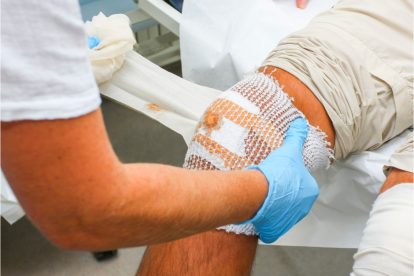Introduction
Wound care monitoring is a necessary element of health care, particularly in the treatment of chronic injuries and complex injuries. Whether it's a basic cut or an extra complicated abscess, reliable injury administration can dramatically affect recovery results. Appropriate strategies not just quicken recuperation yet also lower the threat of infection and problems. As healthcare experts, recognizing these methods is paramount. In this article, we dive deep right into Wound Care Monitoring: Techniques for Effective Outcomes, including various facets such as training for specialists, nursing education and learning, and progressed strategies for managing intricate wounds.
1. Understanding Injury Treatment Management
1.1 What is Injury Treatment Management?
Wound treatment administration describes the methodical technique to treating injuries via appropriate assessment, diagnosis, and treatment protocols. It includes every little thing from cleaning and dressing wounds to monitoring recovery progress.
1.2 Significance of Wound Care
Effective injury care is critical since it aids stop infections, promotes much faster recovery, and eventually lowers health care costs connected with long term treatments.

2. Types of Wounds
2.1 Intense Wounds
Acute wounds are those that recover swiftly without problems. They usually result from surgical procedure or unexpected injuries.
2.2 Chronic Wounds
Chronic injuries linger gradually and are frequently connected with underlying conditions such as diabetes or vascular disease.
3. The Duty of an Injury Treatment Specialist
3.1 What Does an Injury Care Specialist Do?
A wound care expert focuses on identifying and dealing with numerous types of wounds using specialized expertise and techniques.
3.2 Training Needed for Specialists
To become a wound treatment professional, one should undergo strenuous training that includes both academic understanding and functional skills.
4. Wound Care Expert Training
4.1 Overview of Training Programs
Training programs for injury care professionals differ commonly however commonly include coursework on makeup, physiology, and the latest wound care technologies.
4.2 Accreditation Options Available
Various companies provide accreditations in wound care management that improve integrity and experience in the field.
5. Wound Care Training for Nurses
5.1 Value of Specialized Training
Nurses play a critical duty in client care; hence, specialized training in wound monitoring is essential for providing high quality health care services.
5.2 Curriculum Components in Nursing Programs
Most nursing programs currently integrate modules concentrated on basic wound care training to equip registered nurses with essential skills needed in scientific settings.
6. Wound Treatment Educating Courses
6.1 Online vs On-site Courses
With the rise of digital learning systems, many experts are selecting on the internet wound care training courses that supply adaptability without endangering on quality.
6.2 Program Material Overview
Typical training course content includes composition relevant to wound healing, finest techniques in clothing application, infection control measures, among others.
7. Basic Wound Care Training Essentials
7.1 Key Abilities Acquired Through Standard Training
Basic wound care training gears up individuals with abilities like cleansing strategies, applying dressings effectively, and recognizing indications of infection.
7.2 Value of Hands-on Practice
Theory alone isn't enough; hands-on technique is essential for establishing self-confidence and efficiency in taking care of injuries effectively.
8. Advanced Techniques in Complicated Wound Care
8.1 Recognizing Complex Wounds
Complex injuries need specialized treatments because of their nature-- commonly including much deeper cells or underlying wellness concerns that hinder healing processes.
8.2 Treatment Modalities
Advanced modalities consist of unfavorable pressure wound treatment (NPWT), bioengineered tissues, and other innovative methods customized to promote healing in complicated cases.
9. Chronic Wound Care Management Strategies
9.1 Identifying Underlying Causes
Identifying the source of chronic wounds-- be it bad blood circulation or diabetes mellitus-- is crucial for efficient therapy plans.

9.2 Multidisciplinary Approach
A successful persistent injury management technique commonly includes partnership among numerous healthcare providers including dietitians, foot doctors, and physical therapists.
10. The NDIS (National Handicap Insurance Coverage System) & Wound Care
10.1 NDIS Support Services
For people under the NDIS structure requiring recurring wound administration assistance services are essential to ensure they obtain ideal treatment tailored to their needs.
10.2 Funding Options Available
Understanding financing alternatives offered via NDIS permits people to accessibility necessary treatments without monetary burden.
Frequently Asked Questions (FAQs)
Q1: What credentials do I require to become a wound treatment nurse?
A: Normally needs a nursing level along with specialized accreditation in injury monitoring gotten through acknowledged programs or training courses concentrated on nursing injury care training.
Q2: The length of time does it take to complete a wound care training course?
A: Training course duration varies; nevertheless, several on the internet programs can be finished within numerous weeks while thorough qualification programs may take months depending upon depth wound care training and routine flexibility.
Q3: Can I handle my own persistent injuries at home?
A: While some patients can manage small chronic wounds at home with correct education from doctor, serious instances ought to always be assessed by experts to prevent complications.
Q4: Why is infection control important in injury management?

Q5: Exist specific items advised for persistent injury management?
A: Yes! The choice of items relies on the sort of persistent wound; typical alternatives consist of hydrocolloid dressings, alginates, foam dressings and so on, customized based on private requirements assessed by medical care providers.
Q6: Exists recurring education and learning readily available after first certification?
A: Definitely! Numerous companies urge constant professional growth through workshops, seminars, on the internet resources guaranteeing specialists stay updated with developments in effective methods related to chronic injury treatment management.
Conclusion
In verdict, efficient Wound Treatment Administration: Methods for Successful Outcomes rely greatly on skilled specialists who recognize both standard concepts and progressed techniques important for advertising ideal recovery problems across diverse person populaces-- from acute injuries requiring instant interest to complex persistent wounds requiring ongoing evaluation and intervention techniques tailored towards alternative wellness goals. By focusing on education and learning with detailed training programs designed specifically around progressing criteria within this vibrant field-- medical care specialists can enhance their capacity providing outstanding solution while ensuring favorable patient experiences generating successful outcomes over time.